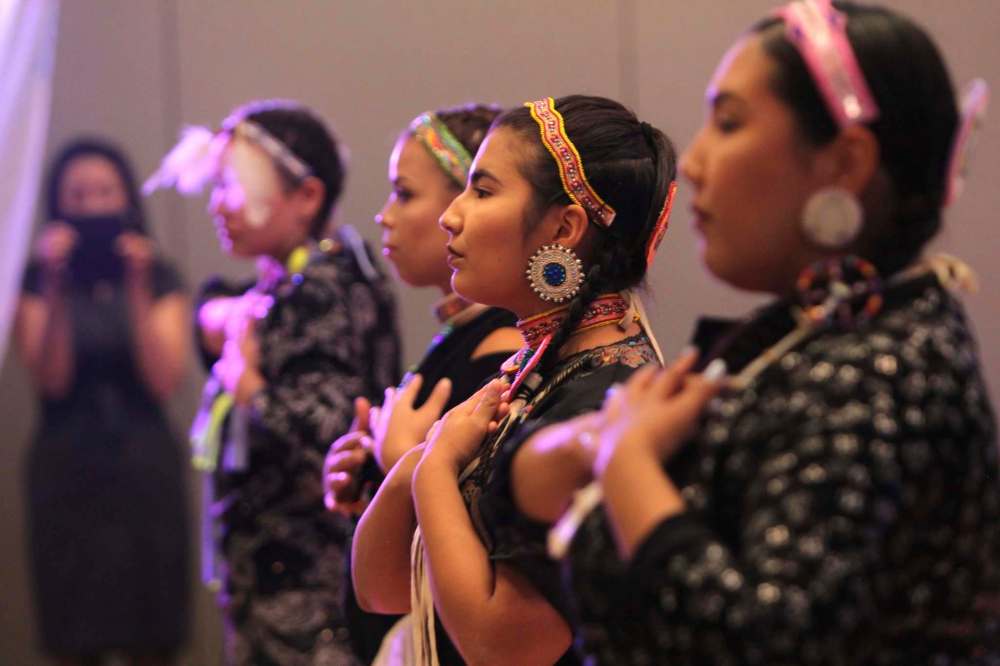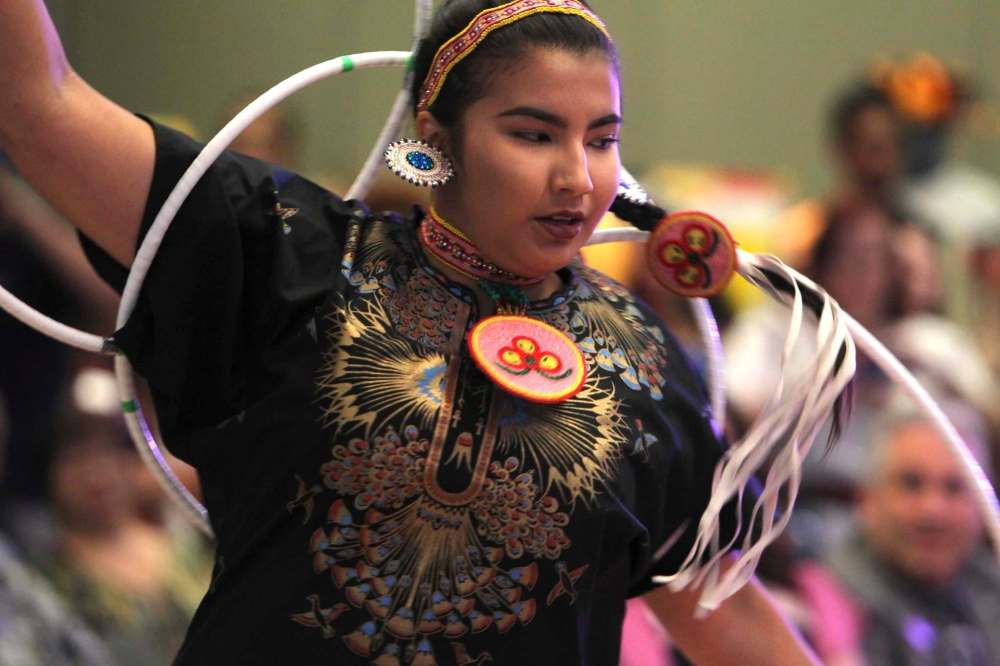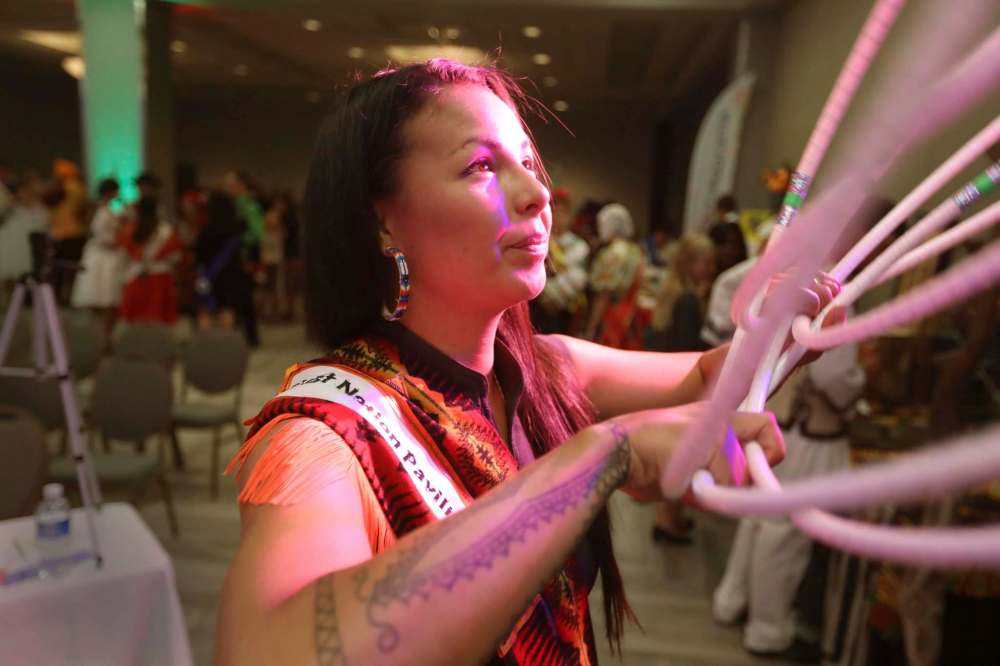Forging new links
New First Nations Pavilion at Folklorama aims to build connections and dispel myths
Advertisement
Read this article for free:
or
Already have an account? Log in here »
To continue reading, please subscribe:
Monthly Digital Subscription
$1 per week for 24 weeks*
- Enjoy unlimited reading on winnipegfreepress.com
- Read the E-Edition, our digital replica newspaper
- Access News Break, our award-winning app
- Play interactive puzzles
*Billed as $4.00 plus GST every four weeks. After 24 weeks, price increases to the regular rate of $19.00 plus GST every four weeks. Offer available to new and qualified returning subscribers only. Cancel any time.
Monthly Digital Subscription
$4.75/week*
- Enjoy unlimited reading on winnipegfreepress.com
- Read the E-Edition, our digital replica newspaper
- Access News Break, our award-winning app
- Play interactive puzzles
*Billed as $19 plus GST every four weeks. Cancel any time.
To continue reading, please subscribe:
Add Free Press access to your Brandon Sun subscription for only an additional
$1 for the first 4 weeks*
*Your next subscription payment will increase by $1.00 and you will be charged $16.99 plus GST for four weeks. After four weeks, your payment will increase to $23.99 plus GST every four weeks.
Read unlimited articles for free today:
or
Already have an account? Log in here »
Hey there, time traveller!
This article was published 05/08/2017 (2997 days ago), so information in it may no longer be current.
Buffy Handel is many things: a dancer, choreographer, entrepreneur, artist, writer, speaker and teacher. The evidence of her work can be found through out the studios at the Aboriginal School of Dance, which she founded in 2008. From the hand-sewn costumes and intricate beadwork — a traditional art she’s been practising since she was three — to the stories she tells about the young people she’s inspired and empowered, her fingerprints are all over the place.
Handel, 36, is bringing her tireless commitment to a new role this year, as co-ordinator of the new First Nations Pavilion at the 48th edition of Folklorama, which kicks off Sunday and runs until Aug. 19. The First Nations Pavilion, sponsored by Neemu-Egwah Inc., will be held during the first week of the festival at the RBC Convention Centre.
This pavilion will be a celebration of the medicine wheel, and the interconnectedness of all life on Earth, from people to animals to plants.
“We picked that theme because of conversations that have been happening in society now,” Handel says over a stolen moment of quiet in her studio. “Truth and reconciliation is a very big topic, and it’s not just an ‘Indian issue,’ it’s an issue that pertains to everybody. The health and well-being of our future, and feeling settled or feeling that we can walk through life with equality, regardless of what ethnicity you are.”

It takes a lifetime to learn all the traditional teachings that exist in a medicine wheel, Handel acknowledges, but one of the fundamentals is balance. The medicine wheel is a circle with two intersecting lines dividing it into four equal quarters. Those lines, Handel explains, represent balance.
“I have this theory that the highest source of medicine in life is love,” she says. “The only way that energy force can ever be generated or stimulated is actually through happiness, and happiness is knowing you’re walking through life in balance.”
The colours of the medicine wheel — red, white, yellow and black — are also significant. They symbolize the four original nations and all the sub-clans within them. They each take up equal space on the wheel; equal weight, equal value. “The original approach to the medicine wheel is about equality, it’s about knowing that we all play a role with each other, and it’s about relationships,” Handel says.
“Relationships are key to the survival of the human race. I don’t think we would have survived as long as we have, as a human race, had we not had these saving moments of working together.”
For Handel, truth and reconciliation is about creating meaningful, productive, open dialogue and, as she says, “you can’t have a dialogue unless you’re inclusive.” The medicine wheel provides an entry point into that dialogue since it, quite literally, includes everyone. It’s in that spirit that this year’s First Nations Pavilion will operate.
“We want to have a positive ripple effect, not only on our Indigenous community, but also on a multicultural level,” she says. “We want people to come into our pavilion and feel appreciated for their presence. We want people to come in to the pavilion and create that happiness, that energy, so that as they leave our doors, they feel loved but they feel that their cup has been filled so they can continue to love.”
It’s been a few years since Folklorama has had an Indigenous pavilion. The last time was in 2013, when there were two: the Indigenous Mardi Gras Pavilion, which was also sponsored by Neemu-Egwah Inc., and the DOTC First Nations Pavilion, which was sponsored by the Dakota Ojibway Tribal Council Inc. (There were no applications to operate a pavilion from — and therefore no licences granted to — Folklorama member organizations identifying as First Nations in 2014, 2015 or 2016.)
Handel is excited to try some new things this year. For example, the pavilion will focus on storytelling instead of powwow demonstrations. Elsewhere, the cultural display will have a museum-level curatorial eye, and there will be real people on hand to answer questions. The food will be prepared by the Indigenous-owned Feast Café and Bistro.

As the pavilion is a youth-empowered project, Handel sees opportunities to create positive energy by not only celebrating Indigenous cultures but also to challenge negative biases and stubborn stereotypes.
“Not only as the director of the non-profit organization Neemu-Egwah but also the pavilion co-ordinator, it is my job to take a look at some of the social issues and also take a realistic look at some of the negative biases about Indigenous people, and take those and keep them in mind while creating the programming, but also the professional delivery of the First Nations Pavilion,” she says.
It was a conscious decision, for example, that no alcohol be served at the pavilion.
“We’ll use another example of a negative bias and term that is quite often used, and people who don’t even associate themselves with Indigenous culture know the term, ‘Indian time,’ which is being late for everything,” she says. “It’s not teaching the kids, ‘Well, this is what Indian time is.’ What it’s about is keeping that negative bias in mind and going, ‘We’re going to set a different standard for the ones we’re training and the ones who are involved in the First Nations Pavilion. Everything we’re going to be doing is on time.’ Once you present that, that’s what they’re going to know.”
Put another way: “When you plant a seed, you want to use sunlight, which is positive energy,” she says. “Why would you surround it in darkness and expect it to grow?”
It was also paramount that the programming at the pavilion drew from all of Manitoba’s Indigenous nations. Indigenous people are not a monolith; take Handel, for example: “I’m from the Algonquin Nation, I grew up in Cree territory but I follow Lakota ceremony,” she says.
The aim, she says, is getting to the “truth of all nations,” which is why the origin story of the four nations, as told to her by late Cree elder Don Cardinal, will be the centrepiece of the show. Everyone, no matter who they are or where they come from, will recognize pieces of themselves and their culture.
“You go into every single pavilion at Folklorama: what pavilion will not have the sound or the visual of a drum? What ethnicity does not have a type of musical instrument that you blow your breath into to create sound? What pavilion is not going to have plants as the source, whether that’s through food that actually feeds you — which is a source of medicine — but also every single medicine on this Earth, which has been extracted from plants,” she says.
“This is how we know, ‘mitakuye oyasin: we are all related.’”
jen.zoratti@freepress.mb.caTwitter: @JenZoratti



Jen Zoratti is a columnist and feature writer working in the Arts & Life department, as well as the author of the weekly newsletter NEXT. A National Newspaper Award finalist for arts and entertainment writing, Jen is a graduate of the Creative Communications program at RRC Polytech and was a music writer before joining the Free Press in 2013. Read more about Jen.
Every piece of reporting Jen produces is reviewed by an editing team before it is posted online or published in print – part of the Free Press‘s tradition, since 1872, of producing reliable independent journalism. Read more about Free Press’s history and mandate, and learn how our newsroom operates.
Our newsroom depends on a growing audience of readers to power our journalism. If you are not a paid reader, please consider becoming a subscriber.
Our newsroom depends on its audience of readers to power our journalism. Thank you for your support.


